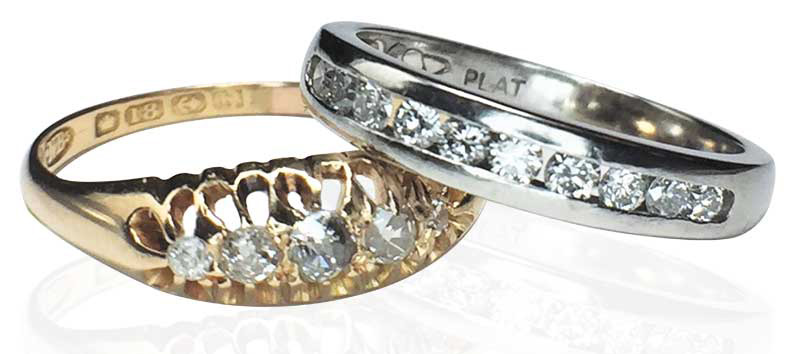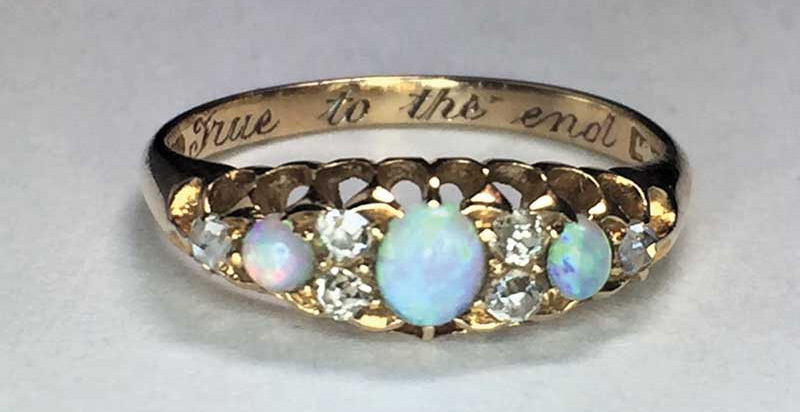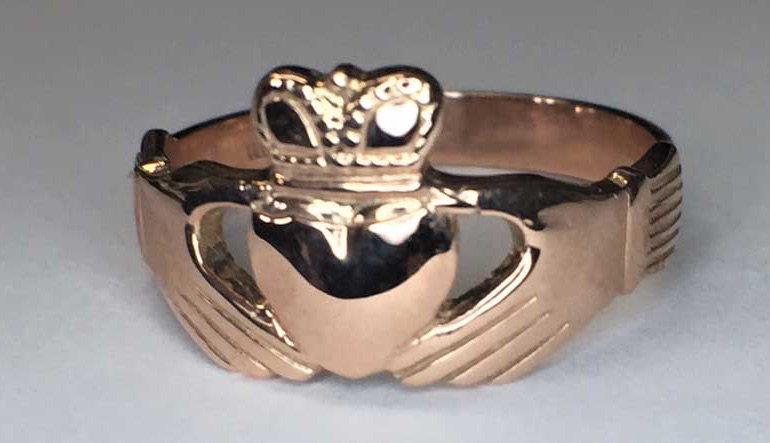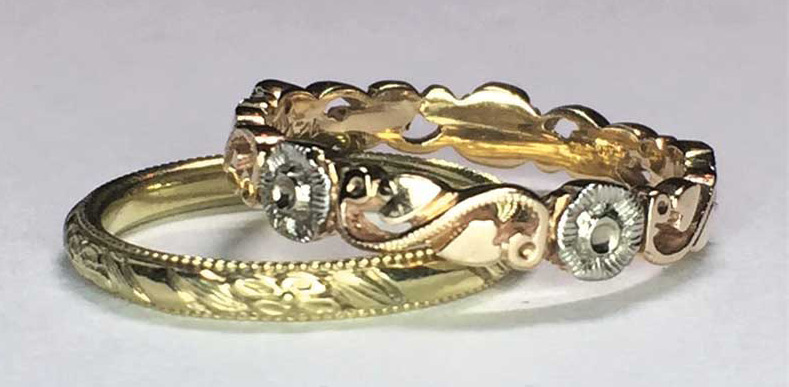With this ring”: Wedding bands through the ages

By Sonja Sanders
Photos courtesy Jewellery by Sanders
Rings are symbolic, sentimental, and have spiritual meaning for the wearer. Indeed, a band’s circular shape is representative of the cycle of life and eternity—it is endless. To many married couples, wedding rings signify their promise of fidelity. Publicly, they show a couple’s commitment to each other.
Who were the first people to wear rings? No one knows for sure, of course. That said, 3000 to 6000 years ago, Egyptians were regarded for their appreciation of symbolism and wore rings to show endless love, represented by the strong bond of the circle. Indeed, in ancient Egypt, women wore decoratively braided rings, which were not made of metal, but of papyrus or reeds. As time passed and societies such as these desired more durable rings, stronger materials—including leather, wood, and ivory—were used to craft them.

Golden promise
Greeks are believed to be the first cultural group to wear gold rings. It was 332 CE when Alexander the Great led the Greeks to conquer the Egyptians. This conquest influenced the Greeks, and one of the traditions they adopted was the giving of rings to signify devotion. In the ancient Roman era, wedding rings were primarily made of iron and, generally, were worn as a symbol of ownership.
In this period, Roman soldiers saw iron as symbolic of strength; signs of wealth were rings made of precious metals.
Dating back 600 years there is evidence in prayer books, ceremony, and legality records, showing marriage was a contract between families. Traditionally, this included an exchange of gold and silver prior to or during a marriage ceremony. This formality was ultimately replaced by the exchange of the gold or silver rings between a betrothed couple. Historically, wedding rings made of gold have been worn since 2000 BCE. In more recent periods, this practice is fairly commonplace, as there are gold mines all over the world; however, in earlier times, this was not the case and it was primarily people of wealth who wore rings made of gold.
While weddings have long been part of religious ceremony in a myriad of cultures, it was the 12th century when the Catholic Church established marriage as a sacrament. This development greatly influenced the tradition of a man giving a woman a ring. Offering one’s love with a ring prior to marriage was a sign of betrothal and represented a serious promise. These wedding rings went on to carry the spiritual significance of commitment.
Vena amoris
One commonly held belief surrounding the tradition of wedding rings is the ‘vein of love,’ which leads directly to the heart, is found on the fourth finger of the left hand. While scientists have, sadly, disproved this, our collective attraction to romance inspires us to maintain the tradition of wearing our wedding rings on this finger. (As practicality would have it, this digit is also thought of as the finger least often used and, since most people are righthanded, there is less chance of damaging a wedding ring worn here.)

Since the 1800s, many European countries have had double-ring ceremonies. In some of these nations, the ring is worn on the left hand for engagement and transferred to the finger on the right hand upon marriage. In the Netherlands, for example, Catholics traditionally wear wedding rings on the right hand when engaged and move them to the left once married; Protestants do the same, but with opposite hands. Likewise, in Jewish ceremonies, the groom puts a wedding ring on the bride’s right index finger.
Whispering sweet nothings
The last few centuries have given us particularly sentimental wedding bands. The posey ring, popularized in the 17th and 18th centuries, was a plain band with a ‘love-themed’ poem or verse engraved inside. This practice slowly evolved into messages being engraved or designed on the outside of a ring in more visible areas.
The fede (‘hands in faith’) ring (also called a gimmel ring) originated as a sign of friendship in the 18th and 19th centuries, but was also worn as a wedding ring. The piece is comprised of three rings, which are stacked together and riveted at the base so they can open beside one another. The central ring features a heart, while the two outside rings each have a hand; when closed, the hands clasp together and encompass the heart. Sometimes, when open, the wearer could admire a gemstone which was set into the heart.
During the early 18th century, the fede was made into a one-ring version, known as the Claddagh ring, which could be worn as a friendship, engagement, or wedding ring. These pieces also traditionally feature a crown in their design. When I first began my career in jewellery retail, I remember an Irish person buying a Claddagh ring and saying to its recipient, “Take my heart into your hands and crown it with your love.” While men sporting engagement rings is, historically, not a common practice, this tradition saw emergence during World War II. Soldiers fighting overseas would regularly wear plain bands to signify engagement (and, presumably, to remember their loved ones back home). These rings usually went on to become their wedding bands.

Modern love
Over the years, wedding rings have taken on different appearances. We regularly see early, traditional styles that carry special meaning for those who wear them, along with design features that are particular to identified fashion eras.
In Georgian times (1714 to 1837), wedding rings were usually made from 18-karat gold. These pieces were often intricately decorated, featuring design elements such as bows, scrolls, flowers, and hearts.
In the mid-1800s, legal standards changed to allow 9-karat to 15-karat gold, making gold rings much more affordable. The Victorian era in England adopted creative band designs in the shapes of snakes, as well as Celtic knots and patterns.
The opening of South African diamond mines in the late 1800s saw diamonds become increasingly popular. As such, it was more commonplace to have engagement rings set with diamonds and wedding rings followed suit.
The first platinum rings were introduced in the Edwardian era (1901 to 1910), coinciding with the art nouveau period. This time saw filigree work, more attention to detail, and goldsmiths striving for perfection in our industry. Designs reflected nature as well as symmetry.
Likewise, the art deco period (1920 to 1940) gave us more geometry and sharp-edged designs. Rings became much more decorative for women. In the 1930s, engagement and wedding rings were seen with the new ‘illusion’ style settings, which helped diamonds appear larger than their carat count.
Of course, WWII saw a stoppage in the use of platinum for jewellery due to war-related requirements and demands. White gold was introduced as a replacement, then rose gold made its popular return. After the war, ring designs became very bold, but there was still a place for plain bands—especially in men’s jewellery.
In the decades that followed, we saw wedding rings with rope designs, braided patterns, and floral accents (again). Platinum came back and rings were popular in two-tone or all yellow. The wedding ring fashion plates ran their cycles; today, a variety of metals and designs are accepted, with preference falling to the wearer.
Currently, in keeping with cyclical fashion trends, wedding sets with ‘vintage’ style and other similar designs are incredibly popular with couples. These romantic pieces circle back to the eras and sentimental times gone by—they are truly timeless!

